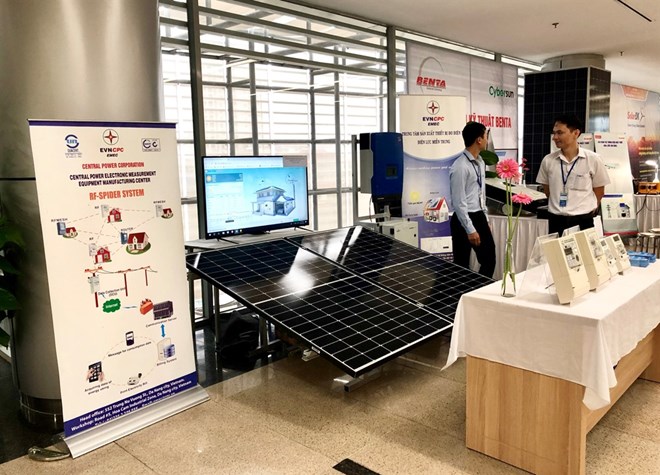
The Electricity of Vietnam introduces a rooptop photovoltaic power station.(Source:VGP )
Vietnam is in the early stages of developing renewable energy sources and needs to introduce more incentive policies to attract more investment, experts have said.
Deputy Minister of Industry and Trade Hoang Quoc Vuong said that the rapid increase in energy demand and consumption, at around 10 percent per year, had negative impacts on the environment as well as exhausted natural resources and affected energy security.
However, the development of clean energy still had certain limitations such as unstable supply, difficulty in energy transmission and high costs, Vuong said, adding that the ministry was studying solutions to efficiently develop renewable energy towards a low-carbon economy.
With a total capacity of nearly 50,000MW, Vietnam ranked second in Southeast Asia and 23rd in the world by power system capacity.
However, it was necessary for Vietnam to develop a structure of energy supply sources, including hydroelectric, thermoelectric and renewable energy, Vuong said.
Promoting an energy transition towards a low-carbon economy was critical, he said.
He cited statistics that the total capacity of hydropower plants reached 22,000MW by the end of 2018. By the end of 2019, the capacity of solar and wind power plants were estimated to reach 1,000MW and 1,500MW, respectively.
Vuong added that the ministry was also receiving a number of proposals to develop wind and solar power projects in the country.
He said that the Government’s target that renewable energy output would account for 20 percent of the power system’s total output could be within reach, providing that Vietnam had attractive policies for investors.
According to Aya Yoshida from the International Energy Agency, Vietnam is in the early stages of developing renewable energy, thus the Government needed to develop appropriate mechanisms to reduce risks for investors in renewable energy development.
She stressed that investing in renewable energy and improving energy efficiency would contribute significantly to reducing CO2 emissions, energy imports and environmental pollution.
Pham Huong Giang, deputy head of the Renewable Energy Department under the Ministry of Industry and Trade, said the ministry was studying mechanisms to promote investment in developing renewable energy.
According to Tran Dinh Nhan, Director of the Electricity of Vietnam (EVN), there was a possibility of power shortages after 2020, thus developing rooftop solar power was considered an important solution to cope with the pressure on power supply.
Although Vietnam had policies for developing solar power with the Prime Minister’s Decision 11/2017/QD-TTg dated April 11, 2017, the development of rooftop solar power remained modest compared to the potential.
As of the end of 2018, EVN installed 54 rooftop solar power projects with a total capacity of 3.2MWp and signed contracts to buy rooftop solar power with 1,800 customers with a total capacity of 30.12MWp. The results were modest compared to the solar power potential in Vietnam, Nhan said.
He questioned whether the rooftop solar power price policies were attractive enough to encourage installation while the costs for rooftop photovoltaic power stations remained high.
Dao Minh Hien from the Power Engineering Consulting Joint Stock Company said the high cost of installation was the major barrier to the widespread development of rooftop solar power systems, adding that models to provide support to citizens to install rooftop panels should be developed.
Several models could be put into consideration such as power companies renting the rooftops of citizens or leasing the photovoltaic power station.
The Ministry of Industry and Trade has recently publicised a draft about mechanisms for new solar power development in Vietnam which was expected to come into effect in June 2019.
According to the draft, the solar power buying prices would range from 1,803 VND to 2,486 VND (7.89 US cents) per kWh, depending on zones classified by solar radiation intensity./.
VNA
 Central bank mulls raising gold position limit for lenders
Central bank mulls raising gold position limit for lenders



